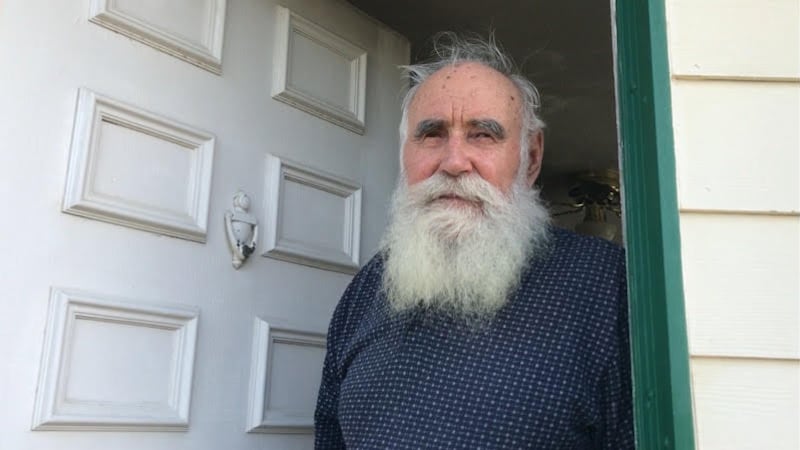It's 7:30 am, the sun barely crawling up into the sky over Woodburn.
I negotiate my way down the Greyhound bus aisle, trying to minimize incidental contact with shut-eyed passengers as I exit at the North Front Street stop, finally making my way off the steps into a cool, clear morning in the heart of the Willamette Valley.
I am here to solve a mystery about a field of corn. Specifically, why someone stomped an intricate design featuring what looks like an "OB."
I spotted that crop pattern in an aerial photo of Woodburn, population 25,000, and I wondered if it might be shorthand for "Old Believers," the sect of religious Russians who live in the area. If so, what was the significance of the image?
To get to the bottom of this, I have to talk to Oregon's Old Believers, or Starovery. This will not be an easy task. The cloistered group, which you may recognize from the Portland-area farmers markets where they sell produce, are descended from Russians who refused to accept the 17th-century reforms of the Russian Orthodox Church pushed for by the tsar. They became second-class citizens, and many fled to Russia's eastern frontier, or left altogether to China, Romania or even Turkey to escape torture and death.

Starting in the 1960s, some Old Believers made their way to Oregon, where a large group settled about 30 miles south of Portland in the fertile Woodburn area. Today they are estimated to number around 10,000.
In Woodburn, they are best known for wanting to be left alone.
"They are extremely hard to talk to and don't want to be public," says Tatiana Osipovich, associate professor emeritus of Russian at Lewis & Clark College, who studied Woodburn's Old Believers in the early 1990s. "You know the Amish, in Pennsylvania? The Old Believers are sort of like Russian Amish."
Indeed, they are a lot like the Amish, or Mennonites—two other religious groups that emerged around the same time. Old Believers tend to shun modern inventions because they basically consider anything that came after the Nikonian reforms to be the work of the devil in a world that has fallen into the hands of the Antichrist—although many do drive cars.
"They are very persistent to have survived persecution all these years," says Osipovich.
To figure out what the "OB" is about, I lined up a guide, a friendly local also named Mike. Other Mike live-streams himself feeding homeless people and anyone else who needs a hot meal in downtown Portland. I met him while covering protests in Portland, and he has occasionally lent me a hand getting to hard-to-access locations.
Anyone from Woodburn knows of the Old Believers, and a little digging reveals several churches situated around Bethlehem Drive, among a dozen in the area.
I was looking at satellite images of these churches to get a feel for the area when I happened upon the "OB" field, which lies near a golden dome. Was the owner of the field an Old Believer? I intended to find out what was going on and also try to strike up a conversation with some Old Believers.

Other Mike picks me up in his blue sedan, and we head south toward Monitor McKee Road, where several other Old Believer churches are located. I have Google Maps open, and as we approach the location of the mystery crop markings, we pass a sign announcing Bauman's Farm, a produce farm best known in the Portland area as a well-trodden pumpkin patch.
The car turns right off of Monitor McKee and down Frolov Drive, where I spot my first Old Believer church. It looks like any other church building or community center, except for the two cupolas adorned with the cross shared by Orthodox Christians and Old Believers. The paint on the largest cupola is worn, and a small dark bird perches atop the cross.
Once back onto Monitor McKee, a large roadside cross dedicated to the Old Believers comes into view on the right. The monument contains two plaques, one in English and one in Old Church Slavonic—the language of Russian Old Believers and the Russian Orthodox Church before the church schism in the 17th century.
Continuing down the road, we come to Bethlehem Drive, where I see a second Old Believer Church. This one is smaller than the first. Several blocks away sits a third church, probably the best known in the area since its crosses and golden domes are visible from Highway 99.
To my surprise, the gates are open at this church. A dozen or so cars are parked outside and inside the church's gates. A man in a dark outfit can be seen at the doors, making ritualistic hand gestures before entering the church. Based on the man's demeanor, the occasion looks serious. I pass through the open gates and under a metal arch to get a closer look. Painted on the outside of the church are icons of many saintly figures, brightly colored and standing in stark contrast to the surrounding fields of brown and gray.

I'm not sure what is going on at the church at this hour—and I don't want to disrespect whatever it is by inserting myself—but I decide to return later in the day to hopefully figure it out.
It's too early to knock on doors, so I have my guide drop me off near the Woodburn Elmer's. A rotund man in overalls outside Elmer's can't be bothered to hear my inquiry about the Old Believers and shoos me away like a fly. My waitress, Selina, doesn't have much to say, either.
Before returning to the area around Monitor McKee Road, I call Bauman's Farm to ask about the OB crop markings. Brian Bauman, the farm's general manager, says the markings are indeed his—the B is for Bauman, and there is no O—but the farm isn't associated with the Old Believers. It's just a corn maze.
What was going on at the large church on Bethlehem Drive? I decide to knock on some more doors, so I catch an Uber back to Bethlehem Drive. All is quiet, except for some workers fiddling with a ditch.
The first door I knock on is the house to the immediate right of the fancy Old Believer church—the gate now shut with no cars to be seen. A man with a formidable gray beard answers. This is 79-year-old Panfil Cam, and though he does not speak much English, we converse a little. He came to the area in 1963, from Konya, Turkey, which he says was "like Woodburn," and where he was a fisherman. Here, he farmed until retiring.

I next venture to an apartment complex along Bethlehem Drive. The second door I knock on is opened by a young boy with a large scab on his cheek. An older woman appears behind him and tells me they don't want to talk.
Then I hear a voice call out from an Old Believer in his 30s whose head appears in an apartment window, his face partially obscured by a bug screen. "Whatever you're here for, it's already over with, so you can go home," the man explains.
The same thing happens again and again, until I come upon a man with a group of small dogs who greets me on his doorstep, wearing paint-stained shorts and a worn shirt. The mass of cars I saw at the church was for a funeral service, he says.

The man in the paint-stained shorts tells me he has keys to a church on Bethlehem Drive, but he won't show me inside. If I want to visit, he says I should return for a service on Saturday night or Sunday.
To talk to an Old Believer, it seems, you must first believe.
I make my way back to Front Street to wait for the Greyhound home.

A Holiday Recipe from Kachka, the Nation's Most Famous Russian Restaurant
A Visit to the Nation's Only Russian-Only Pop Radio Station
Russia's Amish: The Orthodox Old Believers of Woodburn
The Ballet Academy in Beaverton that Trains Champions the Russian Way

